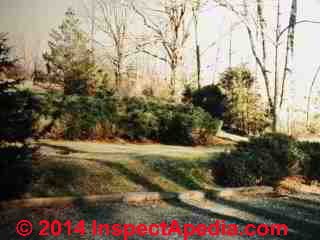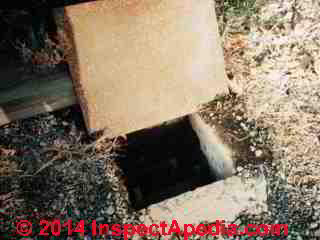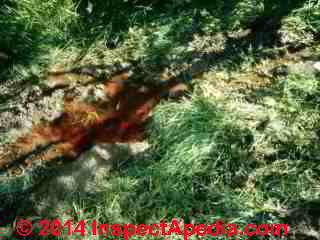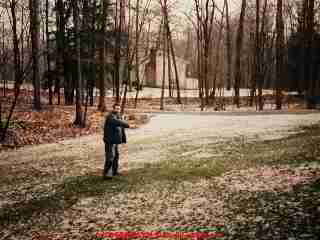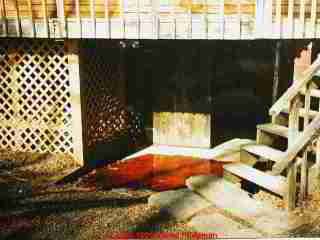 Septic System Failure Spots
Septic System Failure Spots
Where Septic System Trouble is Likely to Show Up Regardless of Dye Testing
- POST a QUESTION or COMMENT about trouble spots in septic systems, how to find where the dye may appear, how to recognize signs of a septic system in failure
Where to look for septic test dye breakouts: this septic system diagnostics article describes where trouble tends to show up at properties with septic systems - if the system is failing, here's where you're likely to see evidence.
A visual inspection of these locations before and after a septic dye test, or a mere inspection of these locations even if no dye test is going to be performed are steps that give key information about the condition of the septic system.
At page top we show the dramatic result of a septic loading and dye test conducted on a septic tank and soakbed located under a driveway and parking area just a short distance from a stream. In wet weather sewage effluent collected in the red-dyed area and flowed into the home's basement - through a doorway in the shadows of our photo.
InspectAPedia tolerates no conflicts of interest. We have no relationship with advertisers, products, or services discussed at this website.
- Daniel Friedman, Publisher/Editor/Author - See WHO ARE WE?
FAILURE SPOTS - Where Septic System Trouble is Likely to Show Up
Besides making the obvious site inspection for sewage odors or breakout at ground surface, simply paying attention to a building site's shape and other visual clues can give critically important information leading to the discovery of a septic system failure, as we will illustrate here.
[Click to enlarge any image]
In our above-left photo we knew that a neighbor's septic drainfield was at the top of the embankment shown. In the photo the most-likely leach field location was on the flat filled area above the landscaped bank shown, we were concerned about effluent breakout under the dense shrubs (where it would be hard to spot).
But we suspected (age, size of fields, etc) that septic problems might be present. In what was reported to be a drain system installed to remove water from the driveway a simple lift of the driveway drain cover on a concrete box found at the bottom of the bank and edge of the drive (photo above right) showed our septic dye running happily along.
The "driveway drain" had actually been installed to carry effluent from the failed leach field across the drive to a nearby storm drain.
The neighbor's septic drainfield was simply sending its effluent next-door.
Understanding the Site Can Point to Areas of Risk of Septic System Failure
Arlene Puentes has pointed out that a septic inspection for failure spots starts with an examination of the whole building site, considering its size, terrain, neighbors, rocks, streams, etc.
Based on property size alone, a very tiny building site should raise an alarm about what septic components could possibly fit and work in the available space. Add considerations of property age and soil conditions and the septic system story may become yet more clear.
At left we show red septic dye in a pre-existing wet area that was down-slope from the septic drainfield area.
By observing that this area was soggy and wet before ever starting the septic loading and dye test, then observing the appearance of our Pylam fluorescent septic dye, we avoided any argument that our test had over-loaded the septic system in the course of detecting this failure.
Puentes reports inspecting a property with a tiny lot, a deck built over the entire back yard, and not much space for a septic tank and drainfield. Starting a normal septic loading and dye test (septic dye placed into the system through a toilet) she soon found water, but not dyed effluent, running out from under the deck.
Placing some dye tablets into a bathtub drain she discovered that all building graywater was directed not into the septic tank but onto the ground surface under the deck. Puentes continued to test the septic tank and drainfield by simply forcing the building toilet to run continuously to place water into that system. In minutes a sewer odor dominated the deck area.
Signs of Trouble in the Septic Leach Field or Drainfield Area:
Look in the area where you think the leach field is or is most likely to be. Look over the edges of mound systems, steep banks, and nearby culverts.
Mound septic system failures: Look over the edges of mound systems, banks, and nearby hills, slopes, or culverts. In this photo our client is pointing to a mound system which was installed across a natural drainage area.
Surface runoff water from nearby properties, and originally this property, used to run along a natural drainage pathway between the road and the lots. When the builder placed this mound system in the front yard he set it atop that drainage pathway - which means that underground water was running a foot or less below the level of the leach field trenches.
The system delivered its effluent right into the surface runoff and together they appeared as dyed effluent at the down slope end of the mound.
Common but illegal effluent discharge pipes:
Some "repairs" to a failed septic system are made by simply running a hidden pipe to a nearby pond, stream, or public storm drain. If there is a nearby common improper pipe target or an unexplained pipe sticking out of a bank, have someone watch this area from the moment dye is placed in the system since if there is a direct drain carrying effluent to such an improper (and illegal) destination, the dyed effluent may pass by quickly.
Streams, ponds, storm drains:
These are common illegal septic effluent discharge targets, especially at sites with limited space, remote country properties, wet areas, and old properties. Look at near by streams, ponds, wet areas that were present before the test. Warning: If you're looking in a nearby stream or storm drain, watch or have someone watch this area from the moment dye is placed in the system.
Some "repairs" to a failed septic system are made by simply running a hidden pipe to a nearby pond, stream, or public storm drain. If there is a free-running pipe carrying effluent to an illegal destination it may flow so easily and quickly that your dye may pass by in just a few minutes, so watch suspect areas closely early in the test as well as throughout.
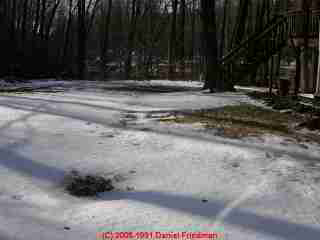 Examine low areas near the septic drainfield,
Examine low areas near the septic drainfield,
soggy areas, areas of dense or lush vegetation, edges of mound systems, and any nearby pond, stream, storm drain, or other surface drainage systems for signs of leakage or dye. Leaf and brush piles or grass clippings are often piled atop "trouble spots" where there has been a history of septic problems and breakout.
- If the ground surface around the septic system is frozen
solid at the time of a septic test (which is not usually the case over an in use drain field, the system is stressed in a different manner, as the leach field does not have the option to relieve its failed absorption area by sending effluent to the surface.
In this condition we have produced backups in the building or at the septic tank during the loading and dye test, so be sure to watch lower floor drains for backups if your test water is being run at upper floors of a building. (Warn clients about the help but also the hindrance provided by snow cover in this regard.) - Look more than once:
Do this visual check before starting the test, during the test, after the test, and up to five days after the site inspection (an added service or an admonition to the client) since it is possible in odd cases for effluent to appear on a property days after the initial test. Fortunately, in cases of a failed or marginal system this procedure often shows breakout in 20-30 minutes.
Technical review by industry experts has been performed and is ongoing - reviewers are listed at "References." Comments and suggestions for content are welcome. © 2017 - 1984 DJF Use of this information at other websites is prohibited; reproduction in electronic or printed form is prohibited.
These pages are part of our SEPTIC DYE TEST PROCEDURE for testing septic system function.
...
Continue reading at SEPTIC ODORS INDICATING DRAINFIELD FAILURE or select a topic from the closely-related articles below, or see the complete ARTICLE INDEX.
Or see these
Recommended Articles
- SEPTIC SYSTEM TEST BASICS - quick guide for buying a home with a septic tank
- HOME BUYERS GUIDE to SEPTIC SYSTEMS - complete guide to buying a home with a septic tank
- HOME SELLERS GUIDE TO SEPTIC INSPECT
- SEPTIC DRAINFIELD INSPECTION & TEST - home
- PLUMBING DRAIN NOISE DIAGNOSIS.
- SEPTIC DISPOSAL FIELD CLOGGING INSPECTION
- SEPTIC DRAINFIELD FAILURE CAUSES
- SEPTIC DRAINFIELD FAILURE DIAGNOSIS
- SEPTIC FAILURE CRITERIA
- SEPTIC FAILURE LAWSUIT
- SEPTIC FAILURE SIGNS
- SEPTIC FAILURE SPOTS
- SEPTIC ODORS INDICATING DRAINFIELD FAILURE
- SEPTIC OUTSIDE INSPECTION - other indicators of a site where septic difficulties may be expected, even if there is not any current evidence of a failure.
- SEPTIC TANK GRASS or SNOWMELT
- SEPTIC TROUBLE SIGNS, OTHER
- SOAKBED SOIL CONDITIONS
- SEPTIC DRAINFIELD LIFE
- SEPTIC DRAINFIELD LOCATION
- SEPTIC DRAINFIELD RESTORERS?
- SEPTIC TANK, HOW TO FIND
- SEPTIC TESTS: DYE & LOADING TESTS
- SEPTIC SYSTEM ODORS
- SEPTIC / SEWAGE SOIL CONTAMINATION HAZARDS
- SEWAGE BACKUP, WHAT TO DO
- SEPTIC TANK LEVELS of SEWAGE
Suggested citation for this web page
SEPTIC FAILURE SPOTS at InspectApedia.com - online encyclopedia of building & environmental inspection, testing, diagnosis, repair, & problem prevention advice.
Or see this
INDEX to RELATED ARTICLES: ARTICLE INDEX to SEPTIC SYSTEMS
Or use the SEARCH BOX found below to Ask a Question or Search InspectApedia
Ask a Question or Search InspectApedia
Questions & answers or comments about trouble spots in septic systems, how to find where the dye may appear, how to recognize signs of a septic system in failure
Try the search box just below, or if you prefer, post a question or comment in the Comments box below and we will respond promptly.
Search the InspectApedia website
Note: appearance of your Comment below may be delayed: if your comment contains an image, photograph, web link, or text that looks to the software as if it might be a web link, your posting will appear after it has been approved by a moderator. Apologies for the delay.
Only one image can be added per comment but you can post as many comments, and therefore images, as you like.
You will not receive a notification when a response to your question has been posted.
Please bookmark this page to make it easy for you to check back for our response.
IF above you see "Comment Form is loading comments..." then COMMENT BOX - countable.ca / bawkbox.com IS NOT WORKING.
In any case you are welcome to send an email directly to us at InspectApedia.com at editor@inspectApedia.com
We'll reply to you directly. Please help us help you by noting, in your email, the URL of the InspectApedia page where you wanted to comment.
Citations & References
In addition to any citations in the article above, a full list is available on request.
- New York State Department of Health, APPENDIX 75-A WASTEWATER TREATMENT STANDARDS - INDIVIDUAL HOUSEHOLD SYSTEMS , [PDF] New York State Department of Health, 3 February 2010, retrieved 3/1/2010, original source: https://www.health.ny.gov/regulations/nycrr/title_10/part_75/appendix_75-a.htm
- Thanks to Arlene Puentes for technical contribution to this article. Arlene Puentes is a licensed home inspector, past chapter president of the Hudson Valley chapter of the American Society of Home Inspectors, an educator, and building failures researcher in Kingston, NY who can be reached at ap@octoberhome.htm or at 845-339-7984. 04/27/2009
- Material Safety Data Sheet MSDS for Red Septic Dye from Tramfloc.
- MSDS for Septic Dye Tablets from Tramfloc.
- MSDS for Septic Dye Liquid from Tramfloc.
- Septic Dye Technical Data Bulletin from Tramfloc.
- Tramfloc, Inc. source of septic system testing tracer dyes
- Bright Dyes Inc. source of septic system testing tracer dyes
- Pollard Water source of septic system testing tracer dyes
- Percolation Testing Manual, CNMI Division of Environmental Quality, Gualo Rai, Saipan provides an excellent English Language manual guide for soil percolation testing. Original source: www.deq.gov.mp/artdoc/Sec6art108ID255.pdf
- Soil Test Pit Preparation, fact sheet, Oregon DEQ Department of Environmental Quality, original source www.deq.state.or.us/wq/pubs/factsheets/onsite/testpitprep.pdf The Oregon DEQ onsite water quality program can be contacted at 811 South Ave, Portland OR 97204, 800-452-4011 or see http://www.oregon.gov/DEQ/
- Thanks to reader Michael Roth for technical link editing 6/29/09.
- SEPTIC TANK/SOIL-ABSORPTION SYSTEMS: HOW TO OPERATE & MAINTAIN [PDF] - , Equipment Tips, U.S. Department of Agriculture, 8271 1302, 7100 Engineering, 2300 Recreation, September 1982, web search 08/28/2010, original source: http://www.fs.fed.us/t-d/pubs/pdfimage/82711302.pdf.
- In addition to citations & references found in this article, see the research citations given at the end of the related articles found at our suggested
CONTINUE READING or RECOMMENDED ARTICLES.
- Carson, Dunlop & Associates Ltd., 120 Carlton Street Suite 407, Toronto ON M5A 4K2. Tel: (416) 964-9415 1-800-268-7070 Email: info@carsondunlop.com. Alan Carson is a past president of ASHI, the American Society of Home Inspectors.
Thanks to Alan Carson and Bob Dunlop, for permission for InspectAPedia to use text excerpts from The HOME REFERENCE BOOK - the Encyclopedia of Homes and to use illustrations from The ILLUSTRATED HOME .
Carson Dunlop Associates provides extensive home inspection education and report writing material. In gratitude we provide links to tsome Carson Dunlop Associates products and services.


